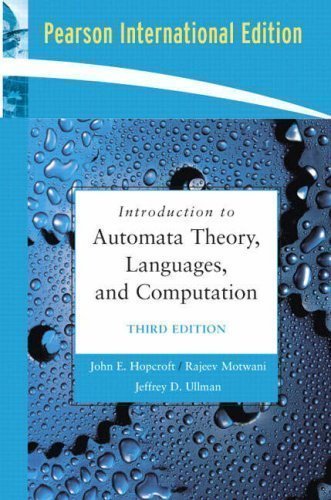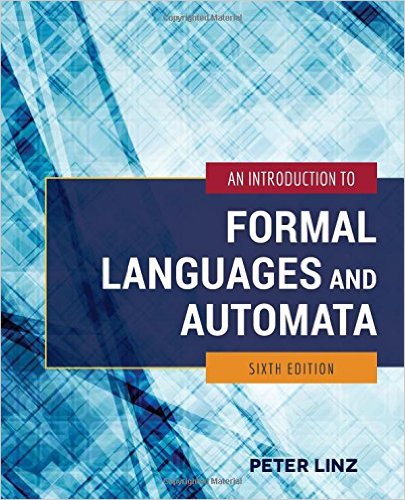 Corrected model solutions
for third set of coursework problems
released!
Corrected model solutions
for third set of coursework problems
released! Corrected model solutions
for third set of coursework problems
released!
Corrected model solutions
for third set of coursework problems
released!
Overview
Literature
Lectures
Lecture Links
Coursework
Forum
Examination
References
Typeset lecture notes [ACN19] (PDF), which includes exercises with model answers, supports the lectures, along with electronic lecture slides [ELS19] for some of the lectures.
Please note that you should not expect these notes to be a complete record of all that is said and discussed during the lectures. Lecture attendance is compulsory, and reading the main references strongly encouraged. That said, the typeset lecture notes are fairly comprehensive.
 |
The book Introduction to Automata Theory, Languages, and Computation, 3rd edition [HMU3] by John E. Hopcroft, Rajeev Motwani, & Jeffrey D. Ullman is the main reference for the course. Note that this book is quite different from the classic 1979 first edition (see below). Consult the book's web pages for additional supporting material, including additional exercises with automated on-line correction, and errata. The library has got some copies of the book. There is now also a third edition of this book. This is fine too. However, the page references below are for the second edition. The 1979 first edition of Introduction to Automata Theory, Languages, and Computation [HU79] by John E. Hopcroft & Jeffrey D. Ullman is very thorough and a classic in the field. However, it is considerably harder than the second and third editions, being aimed more at PhD students or advanced undergraduates. It is now also somewhat difficult to get hold of. |
 |
The book An Introduction to Formal Languages and Automata [Lin6] by Peter Linz can be used as an alternative or complement to [HMU3]. The picture shows the sixth edition. Earlier editions should work too. In fact, as the lectures cover standard material, but without following any specific book very closely, there are a range of possible text books for the student who wish to delve deeper into the subject than what the lectures notes [ACN19] do. |
One important application area for much of the material covered in the course is compilers. If you are curious, you might want to have a look at the material for the second-year module COMP3012/G53CMP Compilers, or you might want to browse through a book on the topic, such as the classic Compilers: Principles, Techniques, and Tools [ASU86] ("The Dragon book") by Aho, Sethi, & Ullman.
| Lecture# | Date | Content | Lctr | Reading |
|---|---|---|---|---|
| 1 | 31 Jan | Administrative Details and Introduction | nhn & vxc | [ELS19, Le 1; ACN19, Sec. 1–2; HMU3, Ch. 1] |
| 2 | 31 Jan | Deterministic Finite Automata (DFA) | nhn | [ACN19, Sec. 3, 3.1; HMU3, Ch. 2, 2.1–2.2] |
| 3 | 7 Feb | Nondeterministic Finite Automata (NFA) | nhn | [ELS19, Le3; ACN19, Sec. 3, 3.2–3.2.2; HMU3, 2.3–2.3.4] |
| 4 | 7 Feb | Equivalence between NFA and DFA | nhn | [ELS19, Le 4; ACN19, Sec. 3, 3.2.3; HMU3, 2.3.5–2.4] |
| 5 | 14 Feb | Regular Expressions | vxc | [ELS19, Le 5; ACN19, Sec. 4, 4.1–4.2; HMU3, Ch.3, 3.1, 3.3] |
| 6 | 14 Feb | Equivalence between Regular Expressions and Finite Automata | vxc | [ELS19, Le 6; ACN19, Sec. 4, 4.3–4.4; HMU3, 3.2.3] |
| 7 | 21 Feb | Proving Languages not to be Regular | vxc | [ELS19, Le 7; ACN19, Sec. 6; HMU3, Ch.4, 4.1, 4.2 (only intro)] |
| 8 | 21 Feb | Introduction to Context-Free Grammars (CFG) | vxc | [ELS19, Le 8; ACN19, Sec. 7, 7.1, 7.6; HMU3, Ch.5, 5.1–5.1.4, 5.3] |
| 9 | 28 Feb | The Language of a CFG | nhn | [ELS19, Le 9; ACN19, Sec.7, 7.2–7.3; HMU3, 5.1.5–5.1.7] |
| 10 | 28 Feb | Derivation Trees and Ambiguity | nhn | [ELS19, Le 10; ACN19, Sec. 7, 7.4–7.5; HMU3, 5.2, 5.4–5.4.1, 5.1.4, 5.4.3–5.4.5] |
| 11 | 7 Mar | Disambiguating Context-Free Grammars | nhn | [ELS19, Le 11; ACN19, Sec. 7, 7.5, Sec. 8, 8.1, 8.5; HMU3, 5.4.2] |
| 12 | 7 Mar | Recursive-Descent Parsing: Introduction | nhn | [ELS19, Le 12; ACN19, Sec. 10, 10.1–10.4; HMU3, 5.3.1-5.3.2] |
| 13 | 14 Mar | Recursive-Descent Parsing: Elimination of Left Recursion | nhn | [ELS19, Le 13; ACN19 Sec. 10.5, 8.1–8.3, 8.6] |
| 14 | 14 Mar | Recursive-Descent Parsing: Predictive Parsing | nhn | [ELS19, Le 14; ACN19 pp. Sec. 10.6–10.7, 8.2, 8.4] |
| 15 | 21 Mar | Turing Machines | vxc | [ELS19, Le 15; ACN19, Sec. 11, 11.1–11.2; HMU3, Ch.8, 8.2] |
| 16 | 21 Mar | λ-Calculus | vxc | [ELS19, Le 16; ACN19, Sec. 12, 12.1–12.5] |
| 17 | 28 Mar | The Church-Turing Thesis | vxc | [ELS19, Le 17; ACN19, Sec. 12.6; HMU3, 8.2.1; Lin6, Ch.13 only intro] |
| 18 | 28 Mar | Decidability and the Halting Problem | vxc | [ELS19, Le 18; ACN19, Sec. 11.3–11.5; HMU3, Ch.9; Lin6, Ch.12] |
| 19 | 4 April | Computational Complexity and the P vs. NP Problem | vxc | [ELS19, Le 19; ACN19, Sec.13, 13.1–13.3; HMU3, Ch.10; Lin6, Ch.13–14] |
| 20 | 4 April | Catch up/Discussion (TBD) | ||
| -- | 11 Apr | NO LECTURE | ||
| -- | 11 Apr | NO LECTURE |
The coursework consists of three problem sets. The average of the best two counts for 25 % of the overall mark for the module. The issue and submission dates are as follows:
| Problem Set# | Issue Date | Submission Date |
|---|---|---|
| 1 (for lect. 1–7) | 20 Feb | 27 Feb |
| 2 (for lect. 8–14) | 13 Mar | 20 Mar |
| 3 (for lect. 15–19) | 3 Apr | 12 Apr |
The deadline for submitting solutions is 3 PM on the submission date. Solutions are to be submitted to the Student Service Centre as handwritten (recommended) or typeset hard copies. The procedure for hard copy submission is explained on the Student Services' Coursework Submission page. This page also provides a link to the standard cover sheet that should be used. Model solutions will normally be released shortly after the deadline. Marks will be released through Moodle and marked solutions will be returned via the Student Service Centre.
To make quick marking and feedback possible, and as model solutions will be released shortly after the submission deadline, late submissions will not be considered. Extenuating circumstances affecting a single problem set are addressed by the rule that only the two best solutions count. In case of valid extenuating circumstances affecting two or more of the problem sets, suitable arrangements will be made.
Problem sets below. Model solutions will be added shortly after the deadlines.
A Moodle Forum for COMP2012/G52LAC has been set up.
The forum is intended for asking questions about and discussing aspects of COMP2012/G52LAC, like the coursework. It will be monitored by the COMP2012/G52LAC team, and we'll endeavour to answer any outstanding questions reasonably quickly. However, any one is free to contribute to the discussions and help with answering questions. Indeed, in the spirit of an on-line forum, you are encouraged to do so!
Of course, we do ask that you do not post the exact solutions to the coursework! The point of the coursework is that you should ultimately solve the problems yourselves so that you know what you have understood and what you need to work more on or ask about.
In the case of a resit examination:
The style of the exam will be similar to two past exams below. These revision notes give more detail on what to revise and some suggestions regarding how to prepare for the exam.
Model solutions for the above past exams: